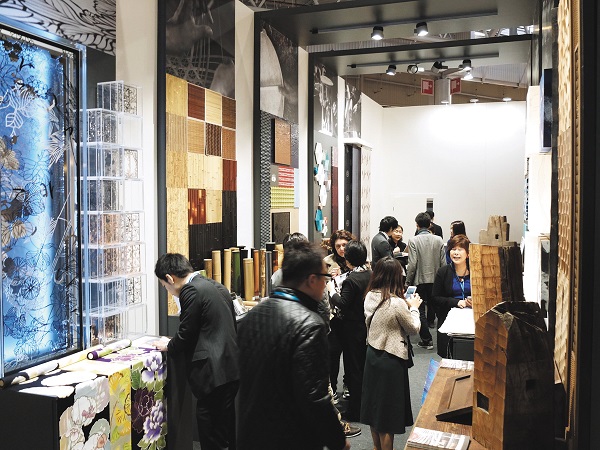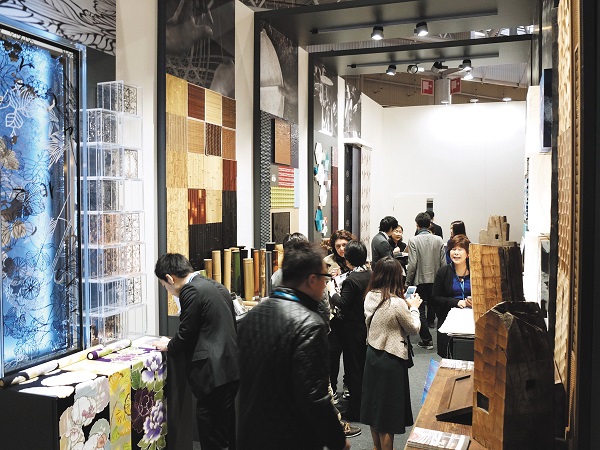Unique designs and techniques are fresh and novel
Kyoto’s traditional crafts as well as textiles and products created by corporations involved in the local industries are gaining greater recognition throughout the global market. From the perspective of Western buyers, the unique designs and techniques are fresh and novel, and apparel and construction companies as well as lifestyle stores at international trade fairs have shown an interest in these crafts. In addition to companies that have broken into overseas markets on their own, there are also companies that have continued to promote their products while receiving support from the government as well as commercial and industrial organisations, marking the spread of earnest overseas expansion efforts.
Artisanal skills from long-established stores
There are many long-established companies in Kyoto that are more than a century old, alongside numerous forms of artisanal skills that have been passed down over the long course of their history. There are also techniques that have survived only in the kimono sector as well as other traditional Japanese industries; these have astonished and amazed overseas buyers, and generated much interest as a characteristic that differentiates Japanese crafts from other products on the market.
Hosoo & Co., LTD., a wholesaler for kimono fabrics and particularly for Nishijin Ori (a traditional brocade textile created in Kyoto), has launched full-scale efforts to develop and sell textiles to the overseas market since its participation in the French trade fair MAISON & OBJET in 2005.
Established in 1688, the company introduced the use of wide fabric looms seven years ago, and has received much acclaim overseas for its delicate textiles made with lacquered gold and silver leaves, and gold and silver yarn. These textiles are used as art pieces or for the interior furnishings of hotels and luxury brand shops.
The collection launched at Milan Design Week (Italy) in April this year, targeted for use in the interior design and fashion sectors, and further promoted the Nishijin Ori production techniques. More than 100 items, including new creations, were put on display. The company also unveiled “tangotango,” an affordable textile produced in collaboration with companies in the Tango production region.
OKAJU Co., ltd., a producer of Kyoto printed silk through the Kyo-yuzen dyeing method, is another company that began promoting its products in the European and American markets more than 10 years ago, such as through trade fairs in France. It has continued to make the presence of its unique branding felt in the global market.
To date, the company has built up a track record in supplying materials for stage costumes used in French operas, and for wrapping materials for luxury tea brands. Last year, its hand-printed polyester crepe fabric, produced in Tango, was selected for use by the American apparel manufacturer, Woolrich, Inc.
The company’s strength lies in its design capabilities and flexibility, built up through 160 years of experience. It has established a product development system that matches the demands of customers, and maintains a strong brand image across a wide range of sectors. Requests for the creation of novelty product lines are also on the rise every year.
KANO-KO is a manufacturer of obi (a cloth belt used for kimono) material in Nishijin. In February this year, it made its debut appearance in the Maison d’Exception area of the Premiere Vision exhibition held in France. This area features manufacturers that possess rare technologies.
Founded in 1889, the company has concluded exclusive agreements with weaving artisans, and boasts a background in integrated production that covers processes from planning to production and sales in the Nishijin region. The 100%-silk KANO KO440 project, which it unveiled at the same exhibition, features a traditional design of studded gold leaves on fabric with a width of 110cm.
The FAB CUIR project applies the traditional technique of Hikihaku (a weaving technique that uses metallic threads). Here, countless layers of gold and silver leaves were placed over each other, while Japanese paper and leather were cut and woven in as the weft yarn. This textile not only attracted interest from influential Western fashion maisons, but also from other participating companies.
Support from the government and other organisations
In Kyoto, government as well as commercial and industrial organisations are active in providing support to small and medium-sized manufacturers and wholesalers in their efforts to expand sales both in Japan and abroad. Kyoto City and the Kyoto Chamber of Commerce and Industry are two such organisations that have kept up their initiatives to promote products to the Western markets. Under the Kyoto Contemporary Project, which focuses on product proposal, 10 companies participated in the MAISON & OBJET in January this year, and engaged in 250 business negotiations.
In the exhibition, Kyoto Bikyo Co., Ltd., a kimono manufacturer, presented a scarf developed jointly with a French textile designer under the KIZOMÉ fashion brand, which harnesses tie-dye techniques in the creation of its products. The scarf is made from Tango silk crepe in ombré-dyed geometric designs, produced through Itajime-shibori (a shape-resist dyeing technique). The company received inquiries about this scarf from distributors for department stores and speciality stores in the United Kingdom, France, and the United States. It also generated sales at the Atelier de Paris, an exhibition and trade fair held during the same period.

Kyoto Bikyo Co., Ltd.’s Tango silk crepe scarf in ombré-dyed geometric designs, produced through Itajime-shibori
DAITOU SHINGU KOGYO Co., Ltd., a bedding manufacturer, exhibited a cotton gauze bedding goods line named “Kyowazarashi Mensya” as a gift product for babies.
The fabric comes in a soft finish, created through the use of two to five layers of additive-free cotton gauze subjected to a four-day bleaching process. Portable bedding, apparel, and lifestyle merchandise have also been created in collaboration with a French designer, and added to the existing line-up of baby bedding. This series of products has won wide acclaim from buyers of luxury fashion maisons, winning reviews such as “Designer lifestyle merchandise that are made in Japan match the needs of our high-end customers.” Thereafter, the company also participated in the American trade fair, NY NOW. This led to new business developments at overseas exhibitions, with four deals in France and four in the United States.
The carved leather iPad cases produced by Nishimura Yuzen Chokoku were also well received at the French trade fair.
The KYOTO CONNECTION project, which focuses mainly on materials and technology, presented seven companies and one group company at the French trade fair. The number of visitors to the booth doubled from the previous year, and it was evident that the Kyoto brand had become established among buyers from the construction industry. Products such as “Urushi Karakami” (lacquered traditional craft paper produced by Maruni Co., Ltd.), “sheer Japanese paper” (WashiLife Co., Ltd.), and “processed black/copper-coloured bamboo” (Yokoyama Bamboo Products & Co) generated much interest among visitors from the construction and interior design sectors.

HOSOO & Co., LTD.’s collection, which promotes the Nishijin Ori technique, on display in Milan, Italy


